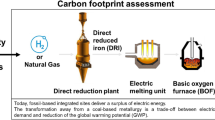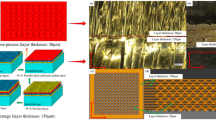Abstract
The increasing demand for metal powders for additive manufacturing applications goes hand in hand with a growing energy consumption for the production of these powders. More demanding powder qualities, e.g. finer powders, might require even higher energy intensities with an increased atomization gas pressure and temperature or higher melt superheat. Furthermore, spherical particles and generally particles with a lower oxygen content demand the use of nitrogen, argon, or even helium as atomization gas instead of compressed air. This study is a contribution to understand the impact of these parameters on the carbon footprint of the metal powder product.
This contribution demonstrates that the energy efficiency of a metal powder production process can be defined by relating the theoretical energy to generate the overall surface of the powder particles as produced by disintegration of the melt flow, which equals the powder’s surface energy, to the actual energy consumption of the atomization process. A simplified melt breakup model based on linear stability analysis is used to estimate the impact of the most important production parameters on the energy consumption of the process. The results from the theoretical modelling are compared to the actual powder production data, and methods to improve the carbon footprint of the atomization process are suggested.
Zusammenfassung
Der zunehmende Bedarf an Metallpulvern für additive Fertigungsprozesse resultiert in einem wachsenden Aufwand an Energiebereitstellung zur Erzeugung dieser Pulverprodukte. Darüber hinaus steigert die Herstellung besonders feiner Pulverqualitäten beispielsweise durch erhöhten Zerstäubungsgasdruck und/oder erhöhte Zerstäubungsgastemperatur bzw. Schmelzeüberhitzung den Energieeinsatz weiter. Sphärische Pulver oder generell Pulver mit einem geringeren Sauerstoffgehalt erfordern den Einsatz von Inertgasen in Form von Stickstoff, Argon oder auch Helium anstatt von Druckluft als Verdüsungsgas. Die vorliegende Untersuchung soll zum Verständnis der Auswirkungen dieser Produktionsparameter auf den CO2-Fußabdruck der Pulverprodukte beitragen.
Die Arbeit zeigt, dass die Energieeffizienz der Metallpulverherstellung quantifiziert werden kann durch das Verhältnis der theoretisch notwendigen Energie zur Erzeugung der Pulveroberfläche beim Zerstäubungsprozess der Metallschmelze, entsprechend der summativen Oberflächenenergie des Pulverprodukts, in Beziehung gesetzt zur tatsächlich aufgewendeten Prozessenergie. Um den Einfluss der wichtigsten Produktionsparameter auf die Energieeffizienz abzuschätzen, wird ein theoretisches Zerfallsmodell basierend auf linearer Stabilitätsanalyse der zerfallenden Flüssigkeitsschichten angewendet und die Ergebnisse mit eigenen Produktionsdaten verglichen. Weiters werden Möglichkeiten zur Verringerung des CO2-Fußabdrucks erörtert.




Similar content being viewed by others
References
Wohlers, T.: Wohlers report 2019. State of the industry—annual worldwide progress report, Fort Collins, Colorado: Wohlers Associates, 2019
United Nations: https://sdgs.un.org/ (29 November 2020)
Yule, A. J.; Dunkley, J. J.: Atomization of melts for powder production and spray deposition, Oxford: Oxford University Press, 1994
Umweltbundesamt: https://www.probas.umweltbundesamt.de/php/prozessdetails.php?id=%7B0E0B2E00-9043-11D3-B2C8-0080C8941B49%7D (30 November 2020)
Dopler, M.: Prediction of particle sizes of gas-atomized metal powders, Ph.D. Thesis, Lehrstuhl für Verfahrenstechnik des industriellen Umweltschutzes, Leoben: University of Leoben, 2017
Dombrowski, N.; Johns, W. R.: The aerodynamic instability and disintegration of viscous liquid sheets, Chemical Engineering Science, 18 (1963) no. 3, pp 203–214
Senecal, P. K.; Schmidt, D. P.; Nouar, C. J.;Rutland, C. J.; Reitz, R. D.; Corradini, M. L.: Modeling high-speed viscous liquid sheet atomization. International Journal of Multiphase Flow, 25 (1999), no 6, pp 1073–1097
Rayleigh, L.: On the instability of jets, Proceedings of the London Mathematical Society, 1 (1878), no. 1, pp 4–13
Delplanque, J. P.; Lavernia, E. J.; Rangel, R. H.: Analysis of in-flight oxidation during reactive spray atomization and deposition processing of aluminum, Journal of Heat Transfer, 122 (2000), no. 1, pp 126–133
Gratzer, P.: Modellierung der Oberflächeneigenschaften von Aluminiumpulver. Bachelor-Thesis, Lehrstuhl für Verfahrenstechnik des industriellen Umweltschutzes, Leoben: University of Leoben, 2012
Ünal, A.: Effect of processing variables on particle size in gas atomization of rapidly solidified aluminium powders. Materials Science and Technology, 3 (1987), no 12, pp 1029–1039
Author information
Authors and Affiliations
Corresponding author
Additional information
Publisher’s Note
Springer Nature remains neutral with regard to jurisdictional claims in published maps and institutional affiliations.
Rights and permissions
About this article
Cite this article
Dopler, M., Weiß, C. Energy Consumption in Metal Powder Production. Berg Huettenmaenn Monatsh 166, 2–8 (2021). https://doi.org/10.1007/s00501-020-01068-w
Received:
Accepted:
Published:
Issue Date:
DOI: https://doi.org/10.1007/s00501-020-01068-w
Keywords
- Linear instability analysis
- Melt sheet breakup
- Secondary droplet breakup
- Droplet solidification
- Sustainable development goals
- Energy efficiency




